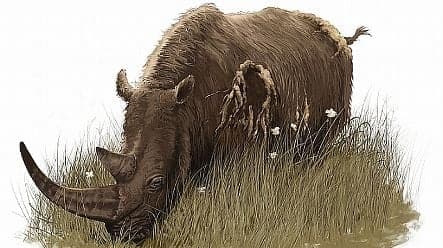Woolly rhinoceros lived in Germany earlier than thought

German palaeontologists have found the remains of a 460,000-year-old woolly rhinoceros, proving the prehistoric species migrated from Asia to Europe much earlier than previously thought.
A bare, treeless landscape, icy temperatures and little precipitation – that's how Germany looked nearly half a million years ago.
But the harsh climate didn't bother the Coelodonta tologoijensis – a well-adapted species of woolly rhinoceros that once grazed at the foot of the Kyffhäuser mountain range in what is now the eastern German state Thuringia.
Scientists at the Senckenberg natural history research institute in Frankfurt have reconstructed a rhino skull providing the first evidence that the species emigrated from Asia far earlier than was widely accepted in archeology circles.
“This is the oldest woolly rhinoceros in Europe,” said Ralf-Dietrich Kahlke, who is the head of the institute 's palaeontology department.
Kahlke's team reassembled the skull out of 50 pieces found in a gravel pit near Bad Frankenhausen 100 years ago. The animal died when it was 12 years old in a melt-water delta that had formed around an inland glacier.
Besides its age, the scientists were able to determine several other characteristics of the woolly rhinoceros from its skull. The animal weighed approximately 1,700 kilogrammes and had two impressive horns on the bridge of its nose. It also likely had thick fur with a long top layer of hair and a warm undercoat.
“With this find we can date precisely for the first time the appearance of cold climate fauna, which spread over almost the entire Asian and European world,” Kahlke said.
The so-called “Mammoth Steppe,” named after the rhino's woolly contemporary, stretched from the Arctic Ocean to the Pacific and extended in the west into Central Europe. Kahlke said Coelodonta tologoijensis survived by keeping its head down so its “lawnmower-like mouth with a massive set of grinding teeth” could scoop up tough, ground-level plants and leaves.
Comments
See Also
A bare, treeless landscape, icy temperatures and little precipitation – that's how Germany looked nearly half a million years ago.
But the harsh climate didn't bother the Coelodonta tologoijensis – a well-adapted species of woolly rhinoceros that once grazed at the foot of the Kyffhäuser mountain range in what is now the eastern German state Thuringia.
Scientists at the Senckenberg natural history research institute in Frankfurt have reconstructed a rhino skull providing the first evidence that the species emigrated from Asia far earlier than was widely accepted in archeology circles.
“This is the oldest woolly rhinoceros in Europe,” said Ralf-Dietrich Kahlke, who is the head of the institute 's palaeontology department.
Kahlke's team reassembled the skull out of 50 pieces found in a gravel pit near Bad Frankenhausen 100 years ago. The animal died when it was 12 years old in a melt-water delta that had formed around an inland glacier.
Besides its age, the scientists were able to determine several other characteristics of the woolly rhinoceros from its skull. The animal weighed approximately 1,700 kilogrammes and had two impressive horns on the bridge of its nose. It also likely had thick fur with a long top layer of hair and a warm undercoat.
“With this find we can date precisely for the first time the appearance of cold climate fauna, which spread over almost the entire Asian and European world,” Kahlke said.
The so-called “Mammoth Steppe,” named after the rhino's woolly contemporary, stretched from the Arctic Ocean to the Pacific and extended in the west into Central Europe. Kahlke said Coelodonta tologoijensis survived by keeping its head down so its “lawnmower-like mouth with a massive set of grinding teeth” could scoop up tough, ground-level plants and leaves.
Join the conversation in our comments section below. Share your own views and experience and if you have a question or suggestion for our journalists then email us at [email protected].
Please keep comments civil, constructive and on topic – and make sure to read our terms of use before getting involved.
Please log in here to leave a comment.